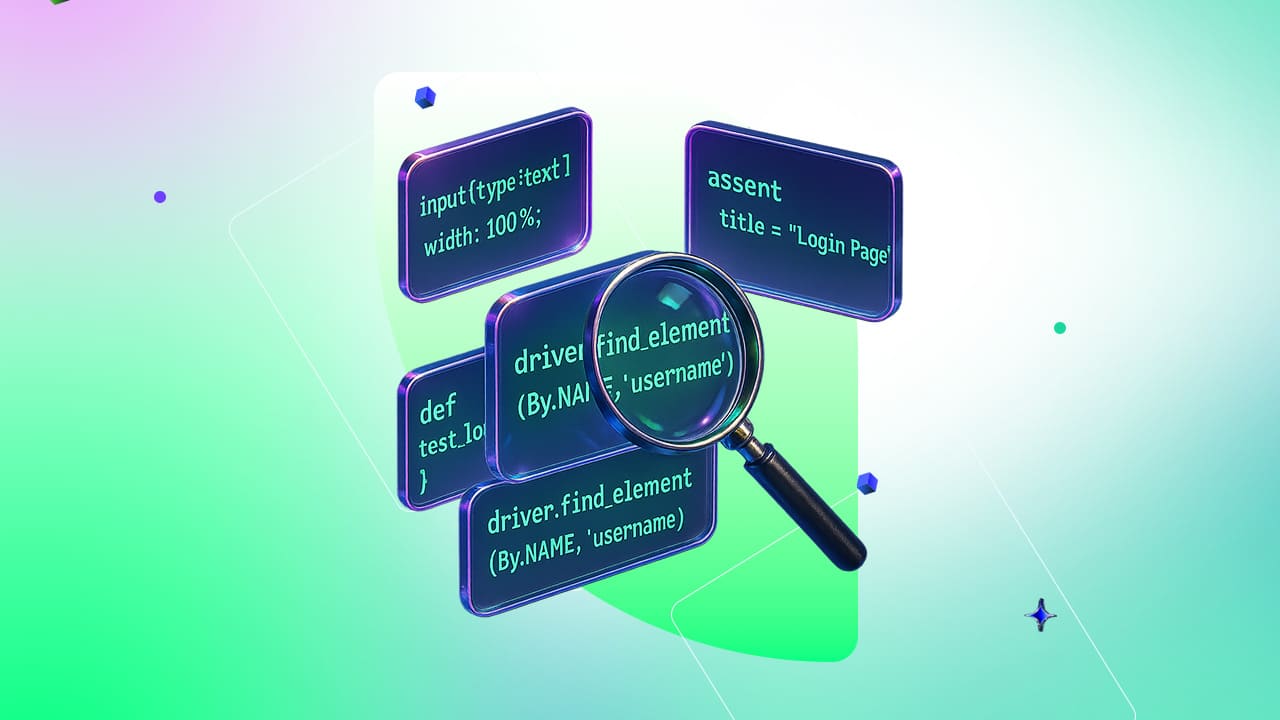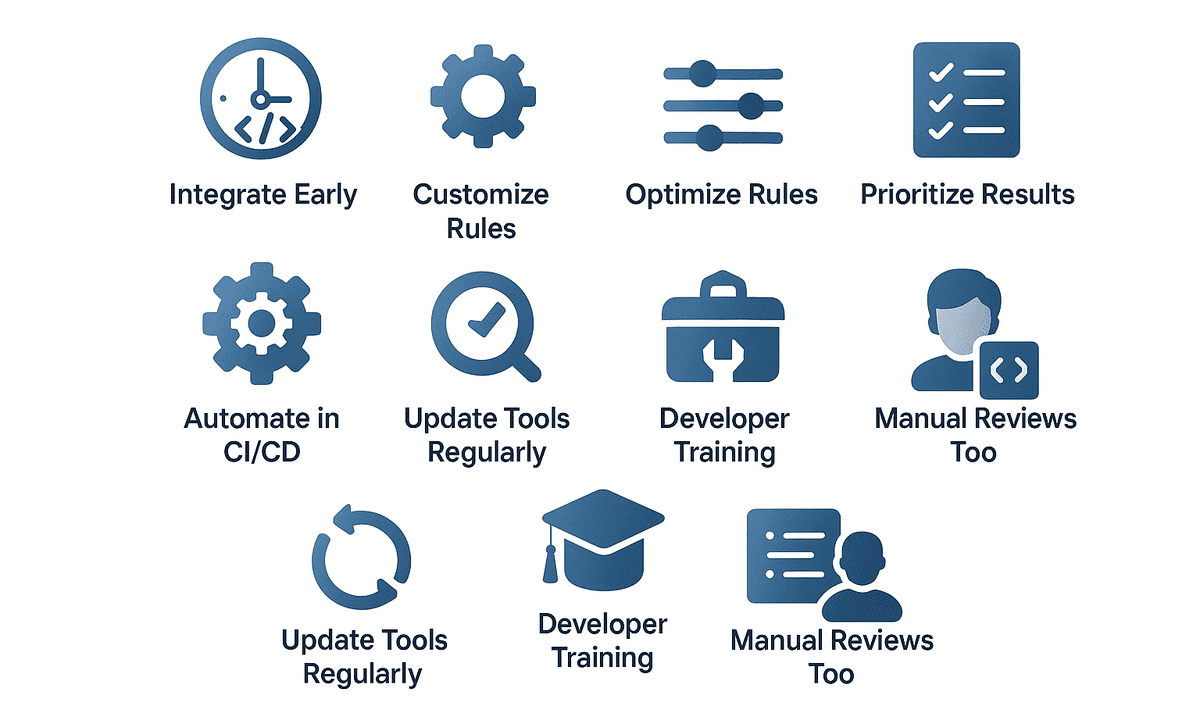Developer’s Handbook to Static Code Analysis & Practices

Static code analysis helps developers identify bugs, security vulnerabilities, and coding standard violations before execution. By integrating static code analysis best practices into the development workflow, teams can enhance code quality, improve code quality, detect bugs early, and make the software maintainable. This guide on static code analysis best practices covers everything from how to improve code quality with static analysis, what tools are right for your project, to integrating them into your workflow.
Whether you are an experienced developer or new to the field, you can leverage the benefits of static code analysis by implementing these practices to help make development easier, minimize bugs, and increase productivity.
- Best Practices for Static Code Analysis
- Integrate Analysis Early in the Development Cycle
- Customize Rules to Minimize False Positives
- Optimize Rules Frequently
- Prioritizing Results
- Automate Checks Within CI/CD Workflows
- Selecting the Right Tool
- Regularly Update Tools for Better Accuracy
- Development and Training
- Combine Static Analysis with Manual Code Reviews
- Conclusion
Best Practices for Static Code Analysis
Static code analysis follows a structured process to examine the source code without executing it. This section covers the best practices for using static code analysis strategies in your workflow. Whether you are focusing on stronger code reliability or better team collaboration, these static code analysis best practices enable developers to catch problems early, reduce technical debt, and deliver quality software with confidence.
Integrate Analysis Early in the Development Cycle
Running static code analysis from the initial stages of the software testing life cycle helps detect errors before they become major issues.
Catching bugs early reduces debugging time and lowers the costs of fixing defects in later stages. Besides preventing bugs with static code analysis, early integration enhances code quality, streamlines workflows, and ensures more reliable software delivery.
Customize Rules to Minimize False Positives
To accomplish accurate and informative results, it is important to configure static code analysis rules so that the number of false positives is as low as possible. Customize rules to match your project’s coding standards, techniques, and needs. Also, continuously improve rules to suit the changing project requirements and keep the efficiency and code quality up while developing.
This eliminates spam of irrelevant alerts, saves developer time, and boosts confidence in the tool.
Optimize Rules Frequently
Regularly reviewing and updating static code analysis rules is essential as projects evolve. Ensure the rules align with the current coding standards, best practices, and project requirements. Modify tool settings to include non-existent rules or new problems.
This ongoing refinement keeps analysis relevant, your code cleaner, and tool support near perfect to your development style, reducing false positives that don’t have to be, and better analysis where it should be.
Prioritizing Results
Triaging static code analysis findings is critical to timely issue remediation. Prioritize findings by how severe and impactful, and kick off with critical issues like security holes or large bugs with a high application risk factor.
This static code analysis best practice helps ensure that priority issues get fixed efficiently, improving software stability and security and minimizing development effort.
Automate Checks Within CI/CD Workflows
Adding static code analysis tools to CI/CD pipelines automates scanning for code with each commit so that no faulty code reaches production. This is done to have consistent, reliable checks that detect problems early and keep development focused and efficient.
By doing that, you automate your existing processes, decrease the manual work, and the result is more code following a standard. By incorporating static analysis into workflows, teams keep their codebases strong and secure, thus improving test automation quality to deliver quickly with confidence.
✅ Improve test automation quality with an AI-powered continuous test automation platform.
👉 Try ACCELQ Now! 🚀
Selecting the Right Tool
The static code analysis tool you choose is critical to achieving higher code quality. Ensure the tool will work with the programming languages and technologies you use in your project. Compare features, like error detection, security scanning, and coding standard enforcement, against your needs.
A good tool increases efficiency, detects things early, and fits in your development workflow perfectly, which results in a better outcome.
Regularly Update Tools for Better Accuracy
Keeping static analysis tools fresh is everything when it comes to accuracy and usefulness. New rule detection precision is improved with new issue rules, while security scanning and new rules are strengthened.
Keeping tools up-to-date helps keep them in line with vulnerabilities and in sync with modern standards to improve code quality and protect applications from greater threats in development that is constantly evolving.
Development and Training
Educating developers on how to read the results of static code analysis to address the reported issues effectively is important. Train to explain conclusions and solve problems found. Foster developer collaboration to learn from one another and write better-quality code together.
This static code analysis best practice develops skills, encourages cooperation, and helps the team use the analytic tools effectively, which results in less error-prone and higher quality, more maintainable software.
Combine Static Analysis with Manual Code Reviews
While static code analysis provides automated insights, it should be complemented by manual code reviews for a more comprehensive evaluation. Developers can assess logic and design choices that automated tools might miss.
However, there is one more approach to code analysis, which shouldn’t be confused with the static or manual approach of dynamic code analysis. The difference between static and dynamic code analysis is that static analysis checks source code for set patterns and errors. In contrast, Dynamic analysis looks at how the program acts when running. Static analysis finds errors by scanning code. By running the program in real-time, dynamic analysis finds issues like memory leaks or crashes.
By following these static code analysis best practices, teams can use static code analysis tools effectively. This helps ensure safe, good, and maintainable software.
Conclusion
Static code analysis is a key practice for producing secure, reliable, and maintainable software. Best practices of automating the analysis in a CI/CD pipeline, modifying rules, and updating tools are used to optimize efficiency, enforce coding standards, and improve security.
Static code analysis works best when you use automation tools like ACCELQ, enabling organizations to optimize test performance and save costs through its AI-powered Test Automation platform, facilitating hassle-free software development and deployment. Teams use sophisticated solutions to develop solid, error-free applications that comply with industry standards.
Geosley Andrades
Director, Product Evangelist at ACCELQ
Geosley is a Test Automation Evangelist and Community builder at ACCELQ. Being passionate about continuous learning, Geosley helps ACCELQ with innovative solutions to transform test automation to be simpler, more reliable, and sustainable for the real world.
You Might Also Like:
 7 Testing Topics that 95% Testers Miss Out On
7 Testing Topics that 95% Testers Miss Out On
7 Testing Topics that 95% Testers Miss Out On
 Introduction to Unit Tests for Power BI Visuals Projects
Introduction to Unit Tests for Power BI Visuals Projects
Introduction to Unit Tests for Power BI Visuals Projects
 Analytical Aspects in Software Testing
Analytical Aspects in Software Testing

































